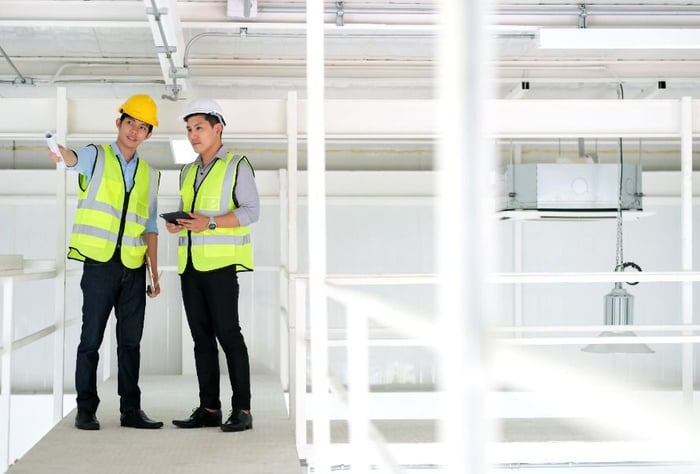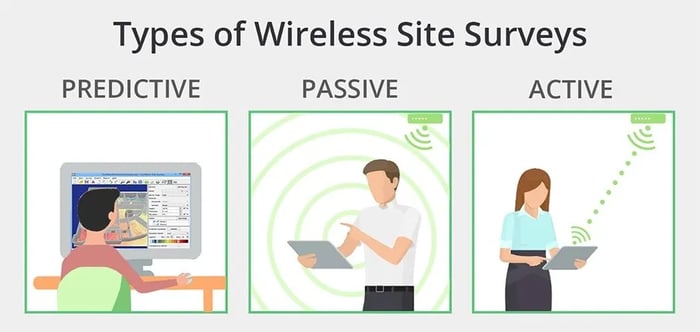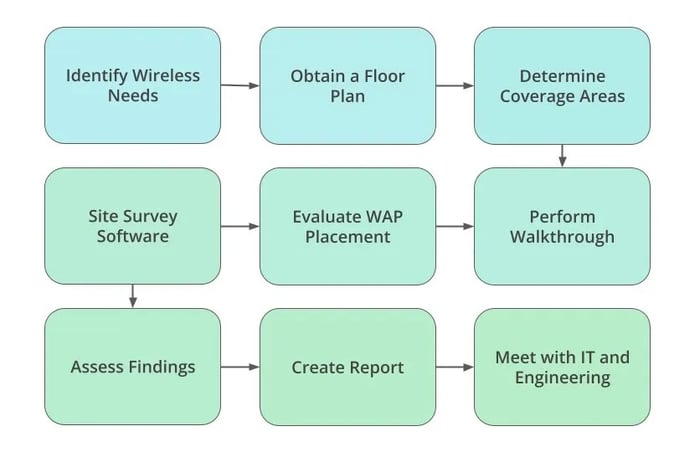Internet access is essential in every business. You must do everything you can to have faster speeds, reasonable data rates, and no issues with infrastructure inhibiting your signal.
What's the best way to ensure a reliable wireless connection for your business? Conduct a wireless site survey.
With a Wireless Site Survey.
What is a wireless site survey?
A wireless site survey is the physical inspection of a site where a wireless radio frequency (RF) network will be installed. The survey assesses the environment to determine wireless coverage, data rates, network capacity, roaming capability, and quality of service and provides site survey insights via Ekahau, AirMagnet, iBwave, etc.
The goal is to visualize the wireless coverage areas (generally through heatmaps) to know where your signal will be strongest and weakest.
Also known as WLAN site survey, wireless network survey, RF site survey, or networking site survey
In other words, a survey is conducted to ensure that your business gets the most from your wireless network and saves you money (and frustration) in the long run.
Site surveys can be conducted in any environment: warehouse, office, hospital, hotel, school, etc.
The two main objectives of a wireless site survey:
- Finding areas of RF coverage and interference
- Determining the placement of access points (APs)

3 Types of Wireless Site Surveys
There are several survey types. You will likely encounter all of them in your site's lifetime. Each type serves a different purpose, so knowing how they differ is essential.
Predictive Site Survey
A predictive site survey is performed without field measurements and relies on computer software, floor plans, and WiFi standards. RF software simulates the building and predicts the number of APs and locations needed to meet the required coverage.
Predictive site surveys do not require an onsite visit, so they are typically used when deploying WiFi in a new space. Predictive surveys are beneficial when budgeting but are only as reliable as the information provided. With this in mind, it's best to do a passive site survey once a site's built to arm the engineer or designer with as much information as possible.
Passive Site Survey
With passive surveys, we do a physical survey of the building to collect data. A physical walk-through of the site ensures that all factors that may impact network performance are accounted for.
The surveying tool is not connected to the WiFi network during the walk-through and only listens to the WiFi environment. The survey software scans specific channels, WiFi networks, and networks to measure signal strength, signal-to-noise ratios, rogue access points, and interference.
Passive site surveys are performed once a space is built, both before a network is operational and routinely after going live to monitor and assess performance.
Click here to download the Wireless Network Purchasing Guide →
Active Site Survey
An active survey is similar to a passive survey, but the survey tools are connected to the network's access points. This allows for an array of information to be gathered, like network traffic, round-trip-time (RTT), throughput, access point locations, and upload/download speeds.
Active site surveys are usually used to troubleshoot WiFi networks and measure the real-world performance of your network. The active site surveys are generally more expensive and need to be conducted during business hours for the most accurate reporting. Still, it collects information the other two survey types can't provide.

Why is a Networking Site Survey Necessary?
When people connect to your network, they aren't just looking at articles. They're streaming, video conferencing, downloading, running several programs at once, and connecting multiple devices.
We live in a world where people expect peak performance all the time. They don't care if they're at a conference with hundreds of others; they want near-instantaneous downloads and minimal latency.
This creates a challenge for IT teams because every space differs, from the ceiling height to the material selection and needs of an organization. A wireless survey will help engineers understand the RF behavior of an area to determine the feasibility of deploying a wireless network that can meet an organization's needs.
Wireless site surveys offer several benefits when planning and implementing a wireless network.
Here are some key advantages:
Here are 3 reasons why site surveys are necessary:
Save Time and Money
Time is money; the longer you spend on network connectivity issues, the more money you'll lose. It's estimated that without a wireless survey upfront, people spend 2 to 3X the cost of a survey trying to fix networking issues. You can either pay a little now to get it right the first time or pay a lot later to troubleshoot and fix it.
Conducting a wireless site survey and spectrum analysis before deployment can save costs by preventing unnecessary AP installations or rework. It ensures that the wireless network is properly planned and optimized from the beginning, reducing the need for costly troubleshooting or retrofitting later on.
The wireless site survey also maximizes the efficiency of network resources, preventing overspending on unnecessary equipment for excessive coverage. The physical hardware also comes with a cost, and having too many APs wastes money with no real benefit. The correct number of APs is a fine line; wireless site surveys can help you determine that.
Optimal Coverage and Performance
Installing the correct number of APs is essential to getting a clear signal. Install too few, and the network will be less clear, fast, and optimal. This can lead to poor signal and dead spots, hurting your bottom line.
On the other hand, install too many, and you're wasting money on unnecessary equipment costs, installation, and maintenance.
A wireless site survey helps determine the optimal placement of wireless access points (APs) to ensure sufficient coverage throughout the intended area. It considers building layout, obstacles, and signal interference to identify ideal AP locations.
Identity Coverage Holes and Interference in Wireless Network
Everything from furniture to people can affect radio frequency. Wireless site surveys will help identify co-channel interferences, troublesome external radio interferences, existing radio sources, and where to place APs for the best coverage to bolster security settings.
Potential sources of interference, such as neighboring WiFi networks, microwave ovens, external radio, co-channel interference, or Bluetooth devices, can be identified and mitigated by conducting a site survey.
Correctly placing APs is key to avoiding these interferences, minimizing overlap from other APs, and eliminating coverage dead zones using the info from the site survey.
The survey helps select the appropriate wireless channels and channel widths to minimize signal conflicts, ensuring a stable, interference-free wireless environment.
But remember, a wireless site survey is a snapshot of your wireless network.
It assesses a site's radio signal profile at that exact moment. As your business evolves, with additional headcount, new furniture, or a refreshed layout, the radio signal profile may change and require a new site survey. This is why we recommend regular passive site surveys.
Efficient Network Planning and Resource Allocation
A wireless site survey enables effective network planning by determining the number of APs required and their optimal placements. It helps allocate network resources efficiently based on the anticipated user density, traffic patterns, and application requirements.
This ensures a well-designed network that can handle the expected load without performance degradation.
Improved Roaming and Seamless Connectivity
A wireless site survey helps determine the optimal signal overlap between adjacent APs, ensuring smooth client roaming within the wireless network.
This results in seamless connectivity and eliminates disruptions or dropped connections when users move between coverage areas. It enhances the user experience, particularly in environments where mobility is crucial, such as office buildings or campuses.
Enhanced Security and Compliance
Wireless site surveys assess the network's security posture by identifying potential vulnerabilities or weak signal areas prone to unauthorized access or signal leakage.
It helps enforce proper security measures, such as implementing strong encryption, access controls, and intrusion detection systems, which contributes to maintaining network confidentiality, integrity, and compliance with regulatory requirements.
How is a Passive Site Survey Conducted?
- The survey engineer will identify your wireless network needs by asking questions like: How fast do you want your internet? How many clients/employees will access the network at once?
- Obtain a floor plan.
- Determine what areas need the most coverage.
- Perform a walkthrough and assess the current infrastructure
- Evaluate where wireless access points (WAPs) can be installed
- Run the data collected from the site visit through the survey software of choice
- Assess the software's findings and make adjustments as needed.
- Record results and build a report that includes mounting locations, cable paths, the scope of work for installation, hardware required, configuration recommendations, licensing information, etc.
- Pass report and findings along to the engineering or IT teams

Upgrading Existing Wireless Networks
There are several reasons to upgrade after undertaking a wireless site survey:
Improved Performance
Technology advancements and increasing demands for higher bandwidth and faster speeds require regular upgrades to wireless networks.
Updating network infrastructure, including access points, controllers, and backhaul connections, allows for improved performance for network managers and enhanced user experience.
The process enables the network to handle increased traffic, support new applications, and accommodate growing user demands.
Enhanced Security
Wireless networks are vulnerable to security threats, such as unauthorized access, data breaches, and malware attacks.
Upgrading the network infrastructure helps implement the latest security protocols, encryption methods, wireless signals, and authentication mechanisms to protect against evolving threats. It guarantees that the network remains secure and compliant with industry standards and regulations.
Increased Scalability
As organizations grow and their new wireless network deployment requirements expand, upgrading the existing infrastructure becomes necessary to support the increased user base and higher data volumes.
Upgrades ensure scalability to accommodate future growth without sacrificing performance or user experience.
Compatibility and Interoperability
Ensures compatibility with newer devices, applications, and network technologies. It facilitates seamless integration with other IT systems and promotes interoperability, enabling efficient collaboration and communication between devices and platforms. This compatibility enhances productivity and facilitates the adoption of new technologies without disruptions.
Cost Efficiency
While upgrading a wireless network incurs upfront costs, it can result in long-term cost savings. Upgraded networks offer better coverage, increased reliability, and reduced operational costs due to frequent maintenance or troubleshooting.
Additionally, upgrading prevents network bottlenecks and performance issues, minimizing potential business disruptions and associated costs.
Future-Proofing
Upgrading existing wireless networks helps future-proof the infrastructure. By adopting the latest technologies and standards, organizations can ensure their networks are ready to handle future demands and emerging technologies.
This proactive approach prevents the network from becoming obsolete and minimizes the need for significant infrastructure overhauls in the future.
By regularly upgrading their wireless networks, organizations can stay ahead of technological advancements, meet evolving user demands, and maintain a reliable and efficient wireless infrastructure.
What Does a Wireless Survey Cost?
Based on our experience, we see predictive site surveys ranging from free to $500+. Active/passive site survey costs vary significantly from $1,500 to $10,000+. Factors that influence price include:
- Size of the building (square footage)
- Type of environment (warehouse, retail, office space, etc.)
- Where the site is located
- Client-specific requirements (turnaround time, after-hours surveying, etc.)
There are plenty of "low-cost" options for wireless site surveys, but you will get what you pay for. If a professional isn't handling your network, there's a greater chance that it won't be optimized to the fullest. Wireless site surveys give you the edge you need.
When your network signal is strong, your business is strong.
Ensure you're using a qualified WiFi engineer with plenty of experience in the field to conduct a wireless site survey. Our team at ASD will take care of it for you and ensure strong wireless coverage, data rates, network capacity, roaming capability, and quality of service.
Contact us to schedule a site survey or learn more about wireless network costs by downloading the purchasing guide.
Editor's Note: This post was originally published in January 2022 and has been updated for freshness, accuracy, and comprehensiveness.



Leave a Comment